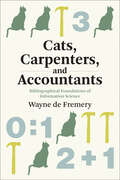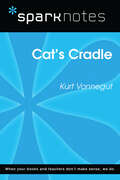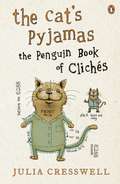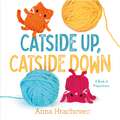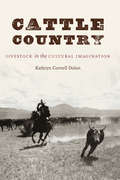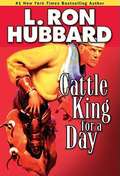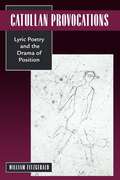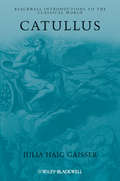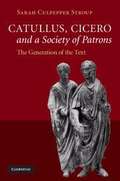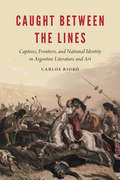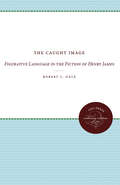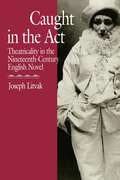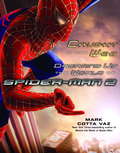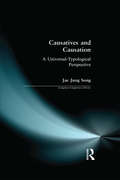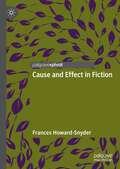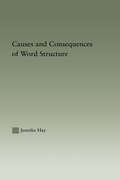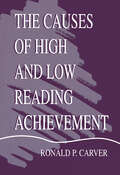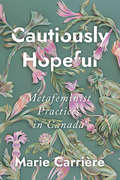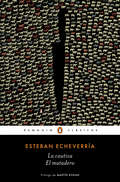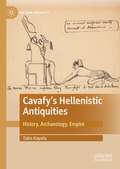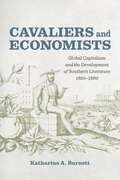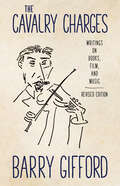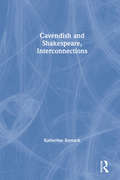- Table View
- List View
Cats, Carpenters, and Accountants: Bibliographical Foundations of Information Science (History and Foundations of Information Science)
by Wayne de FremeryAn expansive case for bibliography as infrastructure in information science.Cats, Carpenters, and Accountants argues that bibliography serves a foundational role within information science as infrastructure, and like all infrastructures, it needs and deserves attention. Wayne de Fremery&’s thoughtful provocation positions bibliography as a means to serve the many ends pursued by information scientists. He explains that bibliographic practices, such as enumeration and description, lie at the heart of knowledge practices and cultural endeavors, but these kinds of infrastructures are difficult to see. In this book, he reveals them and the ways that they formulate information and meaning, artificial intelligence, and human knowledge.Drawing on scholarship from areas as diverse as data science, machine learning, Korean poetry, and the history of bibliography, de Fremery makes the case for understanding bibliography as a generative mode of accounting for what has been received as data, what he calls &“carpentry-accounting.&” Referencing a well-known debate in the Anglo-American bibliographical tradition that features a willful cat, he suggests that bibliography and bibliographers are intentionally marginal figures who, paradoxically, perform foundational work in the service of the diverse disciplinary ends that formulate, however loosely, information science as a field. When we attend to the marginal but essential work of accounting for what humankind has fashioned as recorded knowledge, it becomes easier to consider the ways that human accounts can serve and, sometimes, injure us. Relevant to scholars and students from the sciences to the humanities, Cats, Carpenters, and Accountants is a highly original argument for bibliography as a marginal but foundationally powerful force shaping information science as a field and the ways that we know.
Cat's Cradle (SparkNotes Literature Guide Series)
by SparkNotesCat's Cradle (SparkNotes Literature Guide) by Kurt Vonnegut Making the reading experience fun! Created by Harvard students for students everywhere, SparkNotes is a new breed of study guide: smarter, better, faster.Geared to what today's students need to know, SparkNotes provides:chapter-by-chapter analysis explanations of key themes, motifs, and symbols a review quiz and essay topicsLively and accessible, these guides are perfect for late-night studying and writing papers.
The Cat's Pyjamas: The Penguin Book of Clichés
by Julia CresswellA fascinating, thematic exploration of clichés from as the actress said to the bishop to zero hour, explaining what they are and where they’ve come from. Julia Cresswell has taken her best-selling dictionary of clichés (‘Sumptuous… A mine of information.’ Guardian) back to the drawing board and has created a book, packed with famous (and infamous) quotations and memorable information, that will change the way you see English.
Catside Up, Catside Down: A Book of Prepositions
by Anna HrachovecFilled with whimsical knitted cats, Anna Hrachovec's debut picture book Catside Up, Catside Down blends the silliness of cats with an early introduction to prepositions. Catside up, catside down.Cat on a turntable, spinning around!Under a piano, over the moon, swept high and away by a cat-shaped balloon. A collection of cozy, knitted cats find themselves in all sorts of funny positions in this rhyming picture book that introduces prepositions like over, under, between, beside, and many more!
Cattle Country: Livestock in the Cultural Imagination (At Table)
by Kathryn Cornell DolanAs beef and cattle production progressed in nineteenth-century America, the cow emerged as the nation&’s representative food animal and earned a culturally prominent role in the literature of the day. In Cattle Country Kathryn Cornell Dolan examines the role cattle played in narratives throughout the century to show how the struggles within U.S. food culture mapped onto society&’s broader struggles with colonization, environmentalism, U.S. identity, ethnicity, and industrialization. Dolan examines diverse texts from Native American, African American, Mexican American, and white authors that showcase the zeitgeist of anxiety surrounding U.S. identity as cattle gradually became an industrialized food source, altering the country&’s culture while exacting a high cost to humans, animals, and the land. From Henry David Thoreau&’s descriptions of indigenous cuisines as a challenge to the rising monoculture, to Washington Irving&’s travel narratives that foreshadow cattle replacing American bison in the West, to María Amparo Ruiz de Burton&’s use of cattle to connect race and imperialism in her work, authors&’ preoccupations with cattle underscored their concern for resource depletion, habitat destruction, and the wasteful overproduction of a single breed of livestock.Cattle Country offers a window into the ways authors worked to negotiate the consequences of the development of this food culture and, by excavating the history of U.S. settler colonialism through the figure of cattle, sheds new ecocritical light on nineteenth-century literature.
Cattle King for a Day
by L. Ron HubbardWrangle with the outlaws in the wild, wild west. After receiving word of his grandfather's premature death, Chinook Shannon rides long and hard from Arizona to reach Bull Butte, Montana. When three local road agents fail to stop him from entering town, he arrives only to be told by the local banker that the family's Slash S cattle ranch--the largest in the territory--will be foreclosed in just twenty-four hours.Chinook soon discovers that it may be far tougher than he thought to discover who killed his grandfather and who is trying to take his ranch away, as he faces forgery, sabotage and murder! ALSO INCLUDES THE WESTERN STORY "COME AND GET IT""...Here is nonstop action with a Mark Twain twist." --True West * An International Book Awards Finalist
Catullan Provocations: Lyric Poetry and the Drama of Position (Classics and Contemporary Thought #1)
by William FitzgeraldRestoring to Catullus a provocative power that familiarity has tended to dim, this book argues that Catullus challenges us to think about the nature of lyric in new ways. Fitzgerald shows how Catullus's poetry reflects the conditions of its own consumption as it explores the terms and possibilities of the poet's license. Reading the poetry in relation to the drama of position played out between poet, poem, and reader, the author produces a fresh interpretation of almost all of Catullus's oeuvre. Running through the book is an analysis of the ideological stakes behind the construction of the author Catullus in twentieth-century scholarship and of the agenda governing the interpreter's position in relation to Catullus.
Catullus (Blackwell Introductions to the Classical World #36)
by Julia Haig GaisserCatullus is one of the liveliest and most appealing Roman poets. His emotion, charm, and apparent spontaneity resonate with readers as strongly today as in antiquity. This sophisticated literary and historical introduction brings Catullus to life for the modern reader and presents his poetry in all its variety of emotions, subjects, and styles. Places Catullus in a social, historical, and literary context Examines Catallus's style and subjects, and provides a literary introduction to his major themes of love, social life, and politics Discusses the reception of the poems by translators and interpreters
Catullus, Cicero, and a Society of Patrons
by Sarah Culpepper StroupThis is a study of the emergence, development, and florescence of a distinctly 'late Republican' socio-textual culture as recorded in the writings of this period's two most influential authors, Catullus and Cicero. It reveals a multi-faceted textual - rather than more traditionally-defined 'literary' - world that both defines the intellectual life of the late Republic, and lays the foundations for those authors of the Principate and Empire who identified this period as their literary source and inspiration. By first questioning, and then rejecting, the traditional polarisation of Catullus and Cicero, and by broadening the scope of late Republican socio-literary studies to include intersections of language, social practice, and textual materiality, this book presents a fresh picture of both the socio-textual world of the late Republic and the primary authors through whom this world would gain renown.
Caught between the Lines: Captives, Frontiers, and National Identity in Argentine Literature and Art (New Hispanisms)
by Carlos RiobóCaught between the Lines examines how the figure of the captive and the notion of borders have been used in Argentine literature and painting to reflect competing notions of national identity from the nineteenth to the twenty-first centuries. Challenging the conventional approach to the nineteenth-century trope of “civilization versus barbary,” which was intended to criticize the social and ethnic divisions within Argentina in order to create a homogenous society, Carlos Riobó traces the various versions of colonial captivity legends. He argues convincingly that the historical conditions of the colonial period created an ethnic hybridity—a mestizo or culturally mixed identity—that went against the state compulsion for a racially pure identity. This mestizaje was signified not only in Argentina’s literature but also in its art, and Riobó thus analyzes colonial paintings as well as texts.Caught between the Lines focuses on borders and mestizaje (both biological and cultural) as they relate to captives: specifically, how captives have been used to create a national image of Argentina that relies on a logic of separation to justify concepts of national purity and to deny transculturation.
The Caught Image: Figurative Language in the Fiction of Henry James
by Robert L. GaleGale considers the imagery in all of the 135 novels and short stories of Henry James and presents what may well be the first extensive treatment of figurative language in the complete works of any novelist. All of the images have been recorded, but the author does not claim too much for his deductions concerning them.Originally published in 1964.A UNC Press Enduring Edition -- UNC Press Enduring Editions use the latest in digital technology to make available again books from our distinguished backlist that were previously out of print. These editions are published unaltered from the original, and are presented in affordable paperback formats, bringing readers both historical and cultural value.
Caught in the Act: Theatricality in the Nineteenth-Century English Novel
by Joseph LitvakLitvak demonstrates that private experience in the novels of Austen, Charlotte Brontë, Eliot, and James is a rigorous enactment of a public script that constructs normative gender and class identities. He suggests that the theatricality which pervades these novels enforces social norms while introducing opportunities for novelists to resist them. This approach encourages a rethinking of the genre and its cultural contexts in all their instability and ambivalence.
Caught in the Web: Dreaming up the World of Spider-Man 2
by Mark Cotta VazTheSpider-Man 2Dream Machine—from original idea to final cut— unmasking the creative genius at work in the blockbuster movie The epic adventure of one of the greatest superheroes of all time explodes on the silver screen as never before. Now, in this captivating journey behind the scenes and into the imagination, fans can discover how the myth and magic became real inSpider-Man 2, as they plunge deeper into Spider-Man’s world to meet the characters, explore the environments, and follow the storyline in a stunning visual journey. Packed with hundreds of amazing production illustrations, prepared by many of the most talented illustrators in Hollywood,Caught in the Webfeatures • Original sketches, artwork, and doodles that became the inspirations for characters, sets, and computer–generated imagery • Climactic scenes from the movie as they first appeared in conceptual art • Design work used to develop costumes and visual effects—as well as blueprints and architectural drafts used in the construction of both physical and virtual environments • Unique insights into the genesis of Doc Ock—revealing how he evolved from his comic-book origins • An intimate behind-the-scenes look at the full creative process forSpider-Man 2 Enter the amazing realm where dreams come true and discover how the epic adventure was created as you immerse yourself in the action and atmosphere ofSpider-Man 2, from the first rough sketches to the final on-screen adventure. From the Trade Paperback edition.
Causatives and Causation: A Universal -typological perspective (Longman Linguistics Library)
by Jae Jung SongCausatives and Causation is the first comprehensive study of causative constructions found in the world's languages. This important new research, based on a data base of more than 600 languages, not only investigates fully the richness and variety of causative types, but also presents an alternative perspective to the traditional typological approach. The new typology enables a better understanding of how the human mind cognizes causation and how this is reflected in language. Causatives and Causation is also an important attempt to integrate language typology with diachrony by constructing a diachronic model of causative affixes on the basis of this new typology. Drawing on the theoretical insight of Role and Reference Grammar, this book provides a case study of the causative constructions in Korean, providing additional support for both the proposed new typology and the diachronic model. It also examines the pragmatic foundations of causatives, an important but previously unexplored area of study.
Cause and Effect in Fiction
by Frances Howard-SnyderThis book explores and defends George Saunders’ causal thesis that successful stories are those that establish causation well. The book includes an in-depth discussion of causation’s role in several different key craft elements of fiction writing and examines different theories of causation and their implications for causation in fiction. Other discussions include the role of causation in building suspense, character and causation, causation in dialogue and connections between fiction and counterfactuals (or hypotheticals). The book also considers a number of objections to the causal thesis and offers a reply.
Cause and Effect Reading Comprehension Book Reading Level 3.5-5.0
by EdupressAn effective tool for instruction, practice, and evaluation of student understanding. It includes ideas on how to introduce cause and effect to students, as well as activities to help teach and practice the concept.
Causes and Consequences of Word Structure (Outstanding Dissertations in Linguistics)
by Jennifer HayFirst published in 2003. Routledge is an imprint of Taylor & Francis, an informa company.
The Causes of High and Low Reading Achievement
by Ronald P. CarverThis book describes all of the important factors that cause some students to have low reading achievement and others to have high reading achievement. It concentrates on the main factors that influence how much a student gains in reading achievement during a year of school, or a calendar year. An attempt is made to answer the following questions: what can educators do to increase reading achievement, and what is beyond their influence? The author is directly concerned with achievement associated with normal or typical reading. The focus of the book is on things teachers can do during an entire school year that are likely to improve the reading level and reading rate of students, which in turn, will increase their reading achievement. This effort to specify the most important causes of high and low reading achievement represents an integration of two disciplines of scientific psychology--experimental psychology and psychometrics. A glossary at the end of the book contains definitions of terms and concepts. Helpful appendices explain rauding theory, the three laws of rauding theory, and the equations that can be used to predict the accuracy of reading comprehension, provide conversions among units of rauding rate, and list the numbered equations presented in the book.
Cautiously Hopeful: Metafeminist Practices in Canada
by Marie CarrièreIf feminism has always been characterized by its divisions, it is metafeminism, a term coined by Lori Saint-Martin, that defines and embraces that disorder. As a carefully devised reading practice, metafeminism understands contemporary feminist literature and theory as both recalling and extending the tropes and politics of the past. In Cautiously Hopeful Marie Carrière brings together seemingly disparate writing by Anglo-Canadian, Indigenous, and Québécois women authors under the banner of metafeminism.Familiarizing readers with major streams of feminist thought, including intersectionality, affect theory, and care ethics, Carrière shows how literary works by such authors as Dionne Brand, Nicole Brossard, Naomi Fontaine, Larissa Lai, Tracey Lindberg, and Rachel Zolf, among others, tackle the entanglement of gender with race, settler-invader colonialism, heteronormativity, positionality, language, and the posthuman condition. Meanwhile tenable alliances among Indigenous women, women of colour, and settler feminist practitioners emerge. Carrière's tone is personal and accessible throughout - in itself a metafeminist gesture that both encompasses and surpasses a familiar feminist form of writing.Despite the growing anti-feminist backlash across media platforms and in various spheres of political and social life, a hopefulness animates this timely work that, like metafeminism, stands alert to the challenges that feminism faces in its capacity to effect social change in the twenty-first century.
La cautiva/ El matadero
by Esteban EcheverríaEdición definitiva de dos textos fundacionales de la literatura argentina (El matadero es considerado el primer cuento argentino), con prólogo del escritor y crítico literario Martín Kohan, y nota preliminar a cargo de Alejandra Laera. «Ella va. Toda es oídos; / sobre salvajes dormidos / va pasando; escucha, mira, / se para, apenas respira, / y vuelve de nuevo a andar. / Ella marcha, y sus miradas / vagan en torno azoradas, / cual si creyesen ilusas / en las tinieblas confusas / mil espectros divisar.»La cautiva La cautiva y El matadero ocupan un lugar fundacional en la literatura argentina. Escritos por Esteban Echeverría a fines de la década de 1830, en ellos se diseña, respectivamente, el espacio del desierto inabarcable y el de la violencia política, dos motivos que recorren la poesía y la narrativa de todo el siglo XIX. La cautiva utiliza los recursos del Romanticismo para idealizar la civilización, corporizada en la protagonista, y demonizar al indio, haciendo de la frontera la cifra del encuentro con el Otro. En cambio, el lenguaje crudo de El matadero -publicado de manera póstuma y considerado con el tiempo el primer cuento argentino- pone en escena el enfrentamiento social y, con su crítica al rosismo, inaugura el uso político de la ficción. «Para Esteban Echeverría [...] la cultura popular adquiere ese doble signo: recelo ideológico y seducción estética. No obstante, en El matadero esta cuestión asume una inflexión particular; porque la cultura popular se despliega en él bajo su forma más crispada e intensa: la de la violencia.»Del prólogo de Martín Kohan
Cavafy's Hellenistic Antiquities: History, Archaeology, Empire (The New Antiquity)
by Takis KayalisThis book reinterprets C. P. Cavafy’s historical and archaeological poetics by correlating his work to major cultural, political and sexualized receptions of antiquity that marked the turn of the 20th century. Focusing on selected poems which stage readings of Hellenistic and late ancient texts and material objects, this study probes the poet's personal library and archive to trace his scholarly sources and scrutinize their contribution to his creative practice. A new understanding of Cavafy's historicism emerges by comparing his poetics to a broad array of discourses and intellectual pursuits of his time; these range from antiquarianism, physiognomy and Egyptomania to cultural appropriations of the classics which sought to legitimate British colonial rule as well as homoerotic desire. As this volume demonstrates, Cavafy embraced antiquarianism as an empathetic and passionate way of relating to the past and shaped it into a method that allowed his poetry to render modern meanings to Hellenistic antiquities.
Cavaliers and Economists: Global Capitalism and the Development of Southern Literature, 1820-1860 (Southern Literary Studies)
by Katharine BurnettOffering a compelling intervention in studies of antebellum writing, Katharine A. Burnett’s Cavaliers and Economists: Global Capitalism and the Development of Southern Literature, 1820–1860 examines how popular modes of literary production in the South emerged in tandem with the region’s economic modernization. In a series of deeply historicized readings, Burnett positions southern literary form and genre as existing in dialogue with the plantation economy’s evolving position in the transatlantic market before the Civil War. The antebellum southern economy comprised part of a global network of international commerce driven by a version of laissez-faire liberal capitalism that championed unrestricted trade and individual freedom to pursue profit. Yet the economy of the U.S. South consisted of large-scale plantations that used slave labor to cultivate staple crops, including cotton. Each individual plantation functioned as a racially and socially repressive community, a space that seemingly stood apart from the international economic networks that fueled southern capitalism. For writers from the South, fiction became a way to imagine the region as socially and culturally progressive, while still retaining hallmarks of “traditional” southern culture—namely plantation slavery—in the context of a rapidly changing global economy. Burnett excavates an elaborate network of transatlantic literary exchange, operating concurrently with the region’s economic expansion, in which southern writers adopted popular British genres, such as the historical romance and the seduction novel, as models for their own representations of the U.S. South. Each chapter focuses on a different genre, pairing largely under-studied southern texts with well-known British works. Ranging from the humorous sketch to the imperial adventure tale and the social problem novel, Cavaliers and Economists reveals how southern writers like Augusta Jane Evans, Johnson Jones Hooper, Maria McIntosh, William Gilmore Simms, and George Tucker reworked familiar literary forms to reinvent the South through fiction. By considering the intersection of economic history and literary genre, Cavaliers and Economists provides an expansive study of the means by which authors created southern literature in relation to global free market capitalism, showing that, in the process, they renegotiated and rejustified the institution of slavery.
The Cavalry Charges: Writings on Books, Film, and Music, Revised Edition
by Barry GiffordThe Cavalry Charges: Writings on Books, Film, and Music, Revised Edition is a collection of anecdotal reflections that relate many of the experiences that shaped Barry Gifford as a writer. Representative of Gifford’s body of work, this volume is divided into three sections: books, film and television, and music. Within these sections, Gifford’s best work is showcased, including a nine-part dossier on Marlon Brando’s One-Eyed Jacks in which Gifford examines the public and private lives of those involved in the film. New to the collection are four previously published essays: a brief look at the novels of Álvaro Mutis; a reflection on Gifford’s schooling under Nebraska poet John Neihardt; an essay on Elliot Chaze and his novel Black Wings Has My Angel; and a short piece on Sailor and Lula.
Cavendish and Shakespeare, Interconnections
by Katherine RomackCavendish and Shakespeare, Interconnections explores the relationship between the plays of William Shakespeare and the writings of Margaret Cavendish, Duchess of Newcastle (1623-1673). Cavendish wrote 25 plays in the 1650s and 60s, making her one of the most prolific playwrights”man or woman”of the seventeenth century. The essays contained in this volume fit together as studies of various sorts of influence, both literary and historical, setting Cavendish's appropriation of Shakespearean characters and plot structures within the context of the English Civil Wars and the Fronde. The essays trace Shakespeare's influence on Cavendish, explore the political implications of Cavendish's contribution to Shakespeare's reputation, and investigate the politics of influence more generally. The collection covers topics ranging from Cavendish's strategic use of Shakespeare to establish her own reputation to her adaptation of Shakespeare's martial imagery, moral philosophy, and marriage plots, as well as the conventions of cross dressing on stage. Other topics include Shakespeare and Cavendish read aloud; Cavendish's formally hybrid appropriation of Shakespearean comedy and tragedy; her transformation of Shakespearean women on trial; and her re-imagining of Shakespearean models of sexuality and pleasure.
